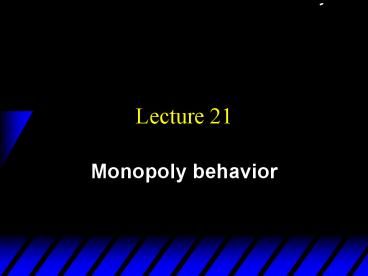Monopoly behavior PowerPoint PPT Presentation
Title: Monopoly behavior
1
Lecture 21
- Monopoly behavior
2
Uniform pricing
p
y
3
Elasticity and markup
4
Gains to trade, CS, PS and DWL
p
y
5
How Should a Monopoly Price?
- The same price for each unit to every customer -
uniform pricing. - Price discrimination many different prices for
the same good - Can price-discrimination earn a monopoly higher
profits?
6
Types of Price Discrimination
- 1st-degree Prices may differ across output units
and buyers. - 2nd-degree Prices may differ across output unit
but not buyers. (E.g. bulk-buying discounts.) - 3rd-degree Prices may differ across buyers but
not output units (student discounts) - Two part tariff
7
First-degree price discrimination
p
y
8
First-degree Price Discrimination
- First-degree price discrimination
- gives a monopolist all of the possible
gains-to-trade, - buyers are with zero surplus,
- efficient amount of output.
9
Third-degree Price Discrimination
- Market has segments - groups of buyers (seniors,
students, adults) - In each segment the same price
- Prices different across groups
- Common in real life
10
Third-degree Price Discrimination
- Example individual buyers, institutions
- Secrets of happiness
11
Third-degree Price Discrimination
- which of the two prices is bigger?
12
Third-degree price discrimination
13
Two-Part Tariffs
- A two-part tariff is a lump-sum fee, p1, plus a
price p2 for each unit of product purchased. - Thus the cost of buying y units of product
is p1 p2y. - Bars, Disneyland, many others
- Optimal design
14
First-degree price discrimination
p
y
15
Two-Part Tariffs
- The monopolist maximizes profit by setting
- by setting per unit price p2 at MC
- lump-sum fee p1 equal to CS.
- Optimal two part tariff
- gives a monopolist all of the possible
gains-to-trade, - buyers are with zero surplus,
- efficient amount of output.
PowerShow.com is a leading presentation sharing website. It has millions of presentations already uploaded and available with 1,000s more being uploaded by its users every day. Whatever your area of interest, here you’ll be able to find and view presentations you’ll love and possibly download. And, best of all, it is completely free and easy to use.
You might even have a presentation you’d like to share with others. If so, just upload it to PowerShow.com. We’ll convert it to an HTML5 slideshow that includes all the media types you’ve already added: audio, video, music, pictures, animations and transition effects. Then you can share it with your target audience as well as PowerShow.com’s millions of monthly visitors. And, again, it’s all free.
About the Developers
PowerShow.com is brought to you by CrystalGraphics, the award-winning developer and market-leading publisher of rich-media enhancement products for presentations. Our product offerings include millions of PowerPoint templates, diagrams, animated 3D characters and more.

